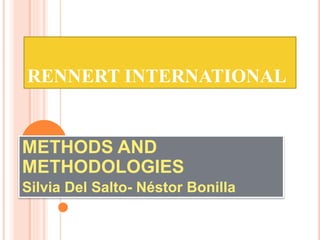
Rennert
- 1. RENNERT INTERNATIONAL METHODS AND METHODOLOGIES Silvia Del Salto- Néstor Bonilla
- 2. METHODS AND METHODOLOGIES Communicative Language Teaching Audio-Lingual Method Total Physical Response (TPR) Grammar-Translation Method Task-Based Learning Project Based Learning (PBL) Natural Approach/ Method Silent Way Community Language Learning Direct Method Suggestopedia Cognitive-Code Approach Content Based Instruction (CBI)
- 3. METHODS AND METHODOLOGIES 1.- Grammar-Translation Method 2.- Direct Method (1900) 3.- Audio-Lingual Method (1950's and 1960's) 4.- Total Physical Response (TPR) (1960s) 5.- Silent Way (1970s) 6.- Community Language Learning (1970’s) 7.- Suggestopedia (1970s) 8.- Cognitive-Code Approach (1970s) 9.- Natural Approach/ Method (early 1980s) 10.- Communicative Language Teaching (1980s ) 11.- Content Based Instruction (CBI) 12.- Task-Based Learning 13.- Project Based Learning (PBL)
- 5. 1.- DRIVING QUESTION – is the question that focuses the students’ work and deepens their learning throughout the process of finding the answer 2.- INDEPTH INQUIRY – students ask questions, search for answers and arrive at conclusions 3.- NEED TO KNOW – students are motivated to learn what is needed to answer the driving question because it has a real world application 4.- 21ST CENTURY SKILLS – critical thinking, teamwork, cooperation, problem-solving, communicating, etc… PROJECT BASED LEARNING
- 6. 5.- STUDENT VOICE/ CHOICE –students have the choice of presentation method; choice of lesson topic & context; students learn to work independently and take responsibility 6.- FEEDBACK & REVISION – students learn to give and receive feedback and think about what and how they are learning and what makes that effective 7.- PUBLICLY PRESENTED PRODUCT – presenting work to other people which increases motivation and adds authenticity PROJECT BASED LEARNING
- 8. USING TEXT BOOKS EFECTIVELY 1.- You already know what you need to cover/teach. So prepare clear objectives for you and your students. objectives should be: SMART Specific ( Specific Target Language, goals – level of accuracy-level of fluency. Connected to a specific activity. Measurable Attainable (accessable, duable, possible) Realistic /real-world applicable (meaningful) Time-bound (it needs to happen in a specific activity at specific time. You have to know when you will assess it.
- 9. USING TEXT BOOKS EFECTIVELY 2.- Once you have your objective you need to use SARA – considering: _ECRIF – FMU-Ways to increase fluency- PBL- TBL- A variety of classroom models + configurations 1.- Select what you want to use 2.- Adapt based on the best way to teach – order of activities. 3.- Reject what is missing 4.- Add in what is missing / new activities like a role- play that aren’t in the book.
- 10. One lesson 50 minutes /4 lessons per day False beginner Level 1 (beginner) = 8 weeks= 160 lessons Beginner Level 2 (elementary) = 8 weeks= 160 lessons Pre-intermed Level 3 (low intermediate) = 8 weeks= 160 lessons Level 4 (low intermediate) = 8 weeks= 160 lessons Level 5 (intermediate) = 8 weeks= 160 lessons Intermediate Level 5 (adv. intermediate) = 8 weeks= 160 lessons longest levels Level 6 (intermediate) = 9 weeks= 180 lessons Level 6 (adv. Intermediate) = 12 weeks= 240 lessons TOEFL 80 Upper-interm. Level 7 (upper Intermediate) = 12 weeks= 240 lessons Level 7 (adv. upper Intermediate) = 10 weeks= 200 lessons Low advanced Level 8 (low advanced) = 10 weeks = 200 lessons Advanced Level 9 (advanced) = 10 weeks = 200 lessons Level 10 (proficient) = 12 weeks = 240 lessons About 4 Years to Cover Levels 1-10 RENNERT LEVELS
- 11. READING SKILL What did you read? (text) How did you read it?(sub-skills) 1.- Predicting A newspaper 2.- Skimming A book 3.- extensive reading A bus schedule 4.- scanning An article/ email/ instructions 5.- intensive reading An extract of an article / an article 6.- gist reading /reading for gist Unfamiliar road signs 7.- inference Other sub-skills happen before or after reading: predicting, summarizing, paraphrasing, interpretation 1- before reading ; 2-7 use these while reading
- 12. TEXTS Example 1.-Authentic texts - an American newspaper - grade the task not the text 2.-Pedagogically prepared text - an article from the textbook 3.-Semi –authentic texts - An authentic story that I adapted to a new version for my class.
